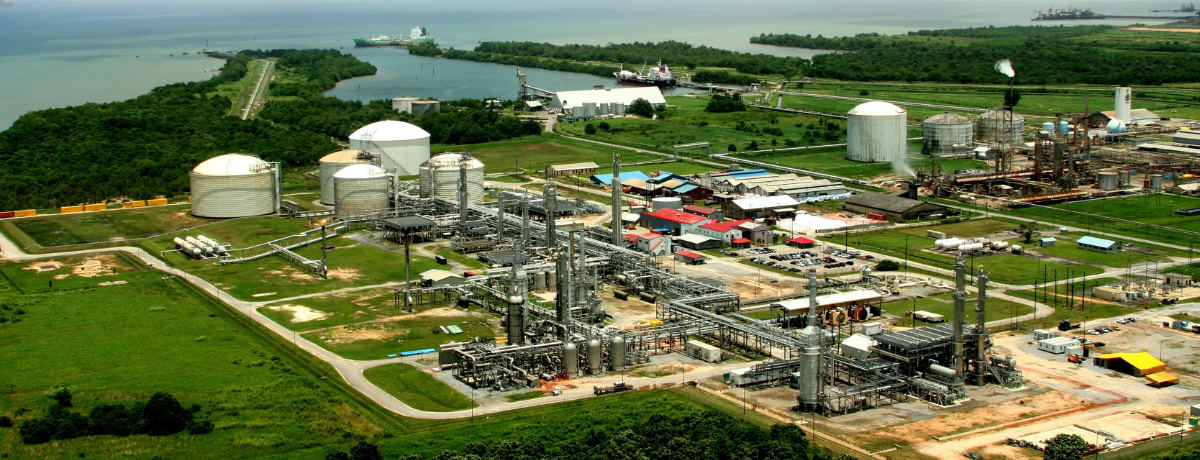
NGC’s Business Model
NGC moves to Point Lisas In 1990, as a full-fledged energy company and…..
NGC moves to Point Lisas
In 1990, as a full-fledged energy company and a major player in the local energy industry, NGC was poised to play an even greater role in the energy sector by relocating closer to the gas-based industries it helped to develop and continued to serve.In August 1990, NGC moved its land-based personnel to the Point Lisas Industrial Estate and into its very own state-of-the-art building located at the corner of Goodrich Bay Road and Orinoco Drive. Keeping to its mandate of delivering value to stakeholders, NGC celebrated a historic achievement of registering TT$113 million in net profit, an increase from TT$80 million a year earlier.
 The beginning of the new decade transformed NGC, both in size and organisation structure. From having just an administrative section headed by a Commercial Manager and a technical section headed by a Gas Engineer, NGC’s workforce increased to 250 with skilled persons in accounting and administration; offshore and land operations; engineering, drawing office and internal audit.
The beginning of the new decade transformed NGC, both in size and organisation structure. From having just an administrative section headed by a Commercial Manager and a technical section headed by a Gas Engineer, NGC’s workforce increased to 250 with skilled persons in accounting and administration; offshore and land operations; engineering, drawing office and internal audit.
To manage its increasingly heightened profile as one of the top five energy companies in the country, a Public Relations Unit was created. Meanwhile, NGC’s gas sales continued to increase and by 1992 reached 513 MMscf/d.
The NEC merger
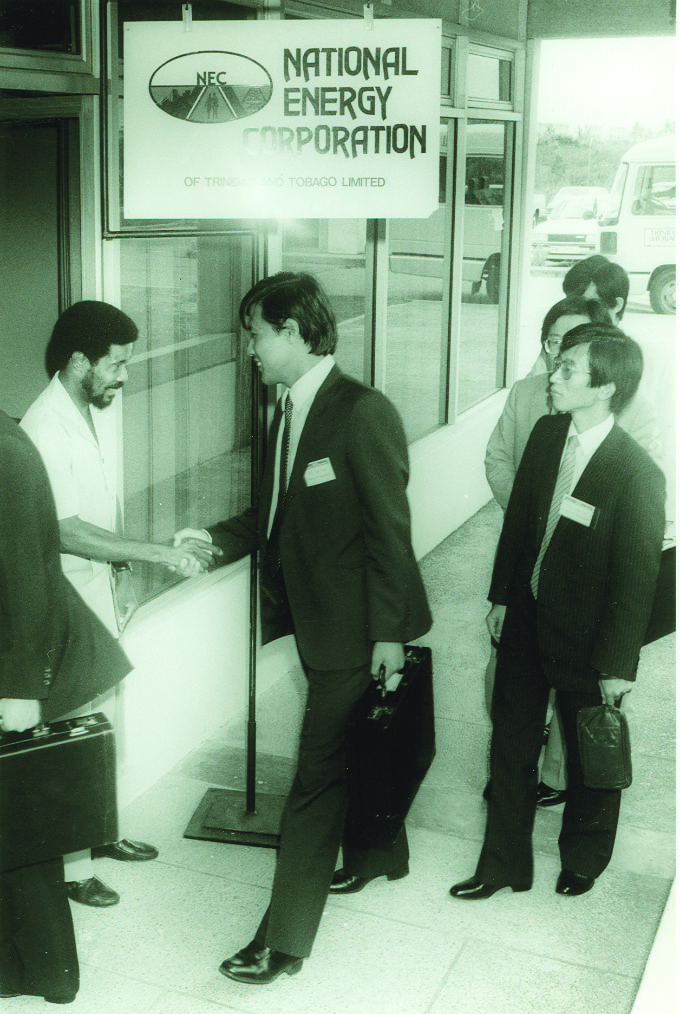 Recognising NGC’s phenomenal success in all its business operations, the Company was given an expanded mandate by the Government, this time to be the ‘prime mover in gas-based development’ to facilitate and promote energy projects that would deepen and broaden gas utilisation.
Recognising NGC’s phenomenal success in all its business operations, the Company was given an expanded mandate by the Government, this time to be the ‘prime mover in gas-based development’ to facilitate and promote energy projects that would deepen and broaden gas utilisation.
This new mandate required a strategic merger between NGC and the National Energy Corporation of Trinidad and Tobago (NEC) with NGC, also acquiring 100% of NEC’s shareholding.
NEC was incorporated in 1979 as a State enterprise to continue the work of the Government-appointed task force to develop and promote the country as a site for gas-based investment, as well as to maintain and develop the marine infrastructure at Port Point Lisas.
NEC, along with the Ministries of State Enterprises, Petroleum and Mines and the State agency, the Industrial Development Corporation (IDC) were responsible for developing the first wave of plants, including the State-owned ISCOTT, TTUC and TTMC, with NEC owning the methanol and urea plants.
By the end of the 1980s, the companies were struggling to survive and new strategies were being sought to sustain and expand the gas industry at Point Lisas, one of which involved the divestment of the State-run petrochemical and steel firms to the private sector to take a leading role in the energy sector’s continued development.
The 1992 NGC/NEC merger also reorganised and consolidated the competencies of the two companies operating in the natural gas sector. NEC, reassigned within the newly structured NGC Business Development Group, provided the competencies of project evaluation and development, gas marketing, infrastructure development, and port and marine construction and management.
Building the gas value chain
NGC was directly responsible for reshaping the natural gas landscape by expanding the market for new business ventures which would yield higher value added projects such as ethylene, syngas, LNG and aluminium smelting, and increased revenues.
Further developments continued as NGC undertook capital expenditures including the upgrade of the NGC Teak and Poui, constructing an additional spur line on the estate to form a ring main pipeline system and constructing an additional berth on the Savonetta Pier known as SP No. 2. It also acquired 20% shareholding of the South East Coast Consortium’s (SECC) lease that had been previously assigned to Trintoc.
During 1992/1993, NGC facilitated the diversification of the country’s offshore production shareholdings which culminated with two new producers coming on stream and enhancing the security and reliability of gas supplies.
NGC also initiated discussions with participants – Cabot, Amoco, BG and Repsol – on the development of LNG production and export. The decision to pursue LNG Train 1 with a probable capacity of 350 MMscf/d came at a time when technological improvements in LNG shipping and storage, as well as the emerging markets in the US and Europe, made it economically feasible.
NGC was also credited with attracting Nucor Corporation to make an investment decision to locate the world’s first iron carbide plant on the estate, making Trinidad a site for new and innovative technologies.
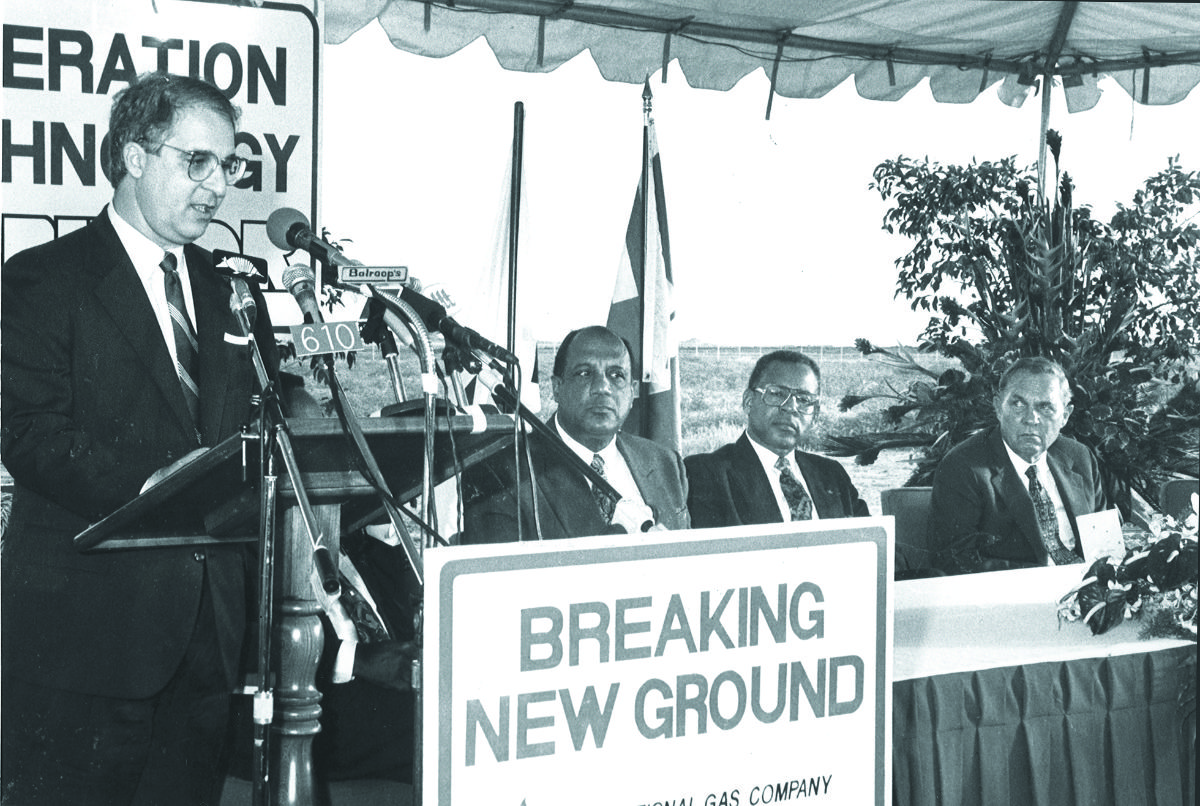 The facilitation of these early business development projects by NGC signaled the start of a new age of industrialised development and vision for the local natural gas landscape which was dominated by petrochemicals (53%), power generation (27%) heavy industry (18%) and light industry (2%).
The facilitation of these early business development projects by NGC signaled the start of a new age of industrialised development and vision for the local natural gas landscape which was dominated by petrochemicals (53%), power generation (27%) heavy industry (18%) and light industry (2%).
The petrochemical industry, for instance, showed the fastest growth of 11% with the establishment of the country’s third methanol plant by private sector investors in 1994. By 1995, NGC’s gas sales were 593 MMscf/d and projected to increase to 683 MMscf/d in 1996.
In July 1995, NGC became one of the participants in the creation of Atlantic LNG, the company formed to manage the proposed LNG processing facility and terminal at Point Fortin.
Expanding the network
Anticipating gas demand by the potential LNG project NGC began expanding its transmission network. Using pipeline-modelling software to determine the optimum expansion model, the project sought to increase capacity from 780 MMscf/d to 1.4 Bcf/d and entailed the construction of 42 miles of 36-inch-diameter landlines from Beachfield Valve Station to Phoenix Park Valve Station, as well as a modification of the downstream distribution network.
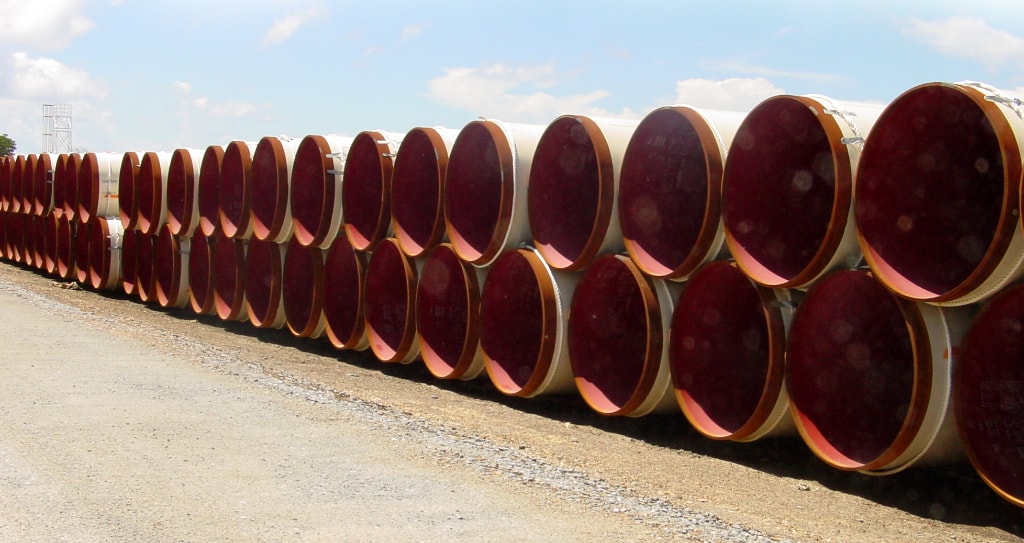 The software was aptly named ‘Project 2000’ in anticipation of the expected ‘boom’ of petrochemical and steel plants to be constructed and on stream by the year 2000
The software was aptly named ‘Project 2000’ in anticipation of the expected ‘boom’ of petrochemical and steel plants to be constructed and on stream by the year 2000
A new estate
Despite the beehive of activity in different aspects of its operations, NGC was also keen to develop a new estate, particularly when along with Plipdeco, it recognised that the 800-hectare estate would approach maximum utilisation by the end of the decade and would be unable to provide land space for new projects. These realities compelled NGC to locate an industrial site that met the needs of investors.
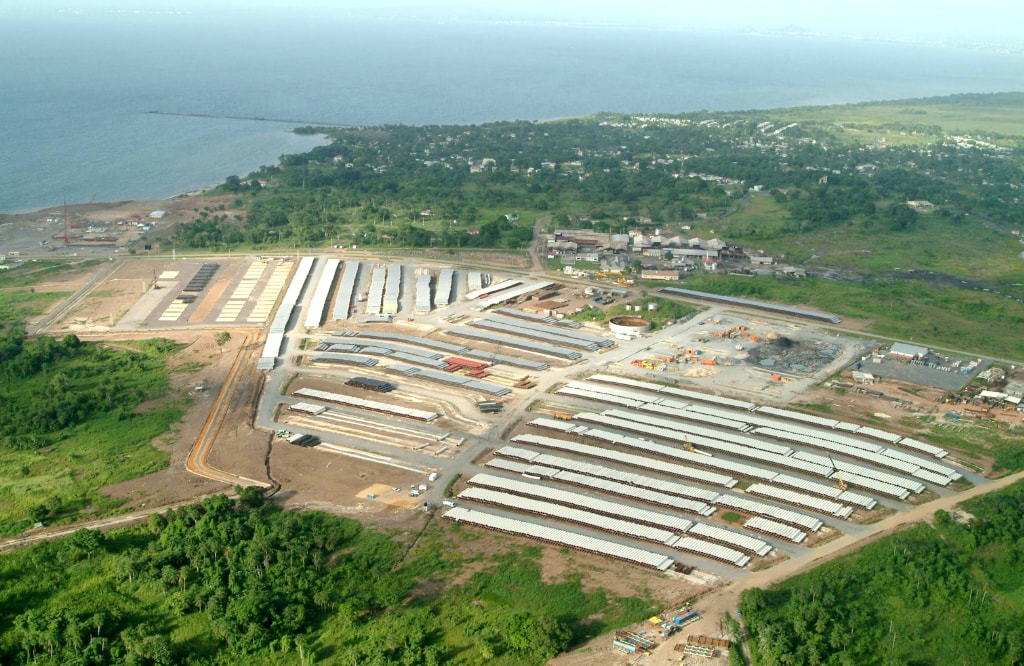 In late 1993, the La Brea/Brighton area, the location of a refining operation in the previous century, was chosen as the best possible site for prospective industrial investors particularly its proximity to one of the country’s remaining natural deepwater harbours.
In late 1993, the La Brea/Brighton area, the location of a refining operation in the previous century, was chosen as the best possible site for prospective industrial investors particularly its proximity to one of the country’s remaining natural deepwater harbours.
By February 1994, NGC, in a joint venture with Petrotrin, the La Brea site’s former landowner, formed the La Brea Industrial Development Company Limited (LABIDCO). LABIDCO was tasked with managing the estate’s development which was earmarked to house large gas-based industries such as LNG and the world’s largest ammonia facility and was poised to become a second natural gas cluster in the new wave of natural gas development.
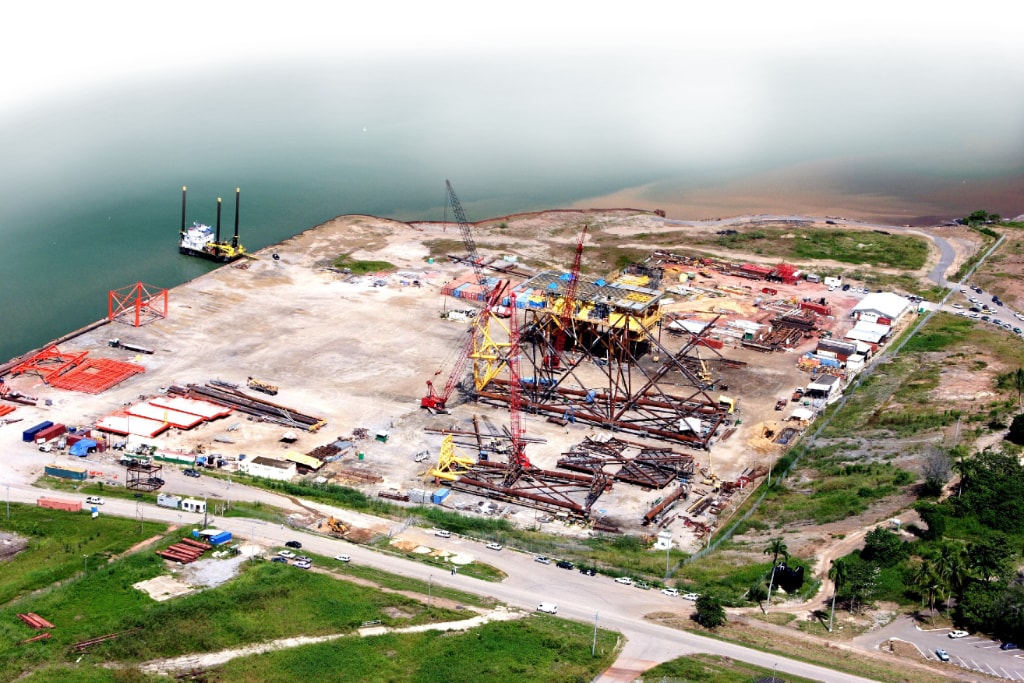 The plans, however, did not materialise as the new industrial estate was instead developed and marketed in 1996 by the newly installed Panday Government as a provider of developed lands for leasing purposes, harbour and dock facilities, bioremediation services and as a logistics base for offshore companies.
The plans, however, did not materialise as the new industrial estate was instead developed and marketed in 1996 by the newly installed Panday Government as a provider of developed lands for leasing purposes, harbour and dock facilities, bioremediation services and as a logistics base for offshore companies.
Vision 2001
Despite its unrivalled success as a State enterprise and bolstered by 21 years of sustained and progressive profitability, events worldwide were beginning to impact the industry requiring major changes in areas of deregulation, competition and technology.
Recognising that it had to redefine its vision for the future,
NGC’s focus turned to the growth of the Company and the industry which lay in the development of a five-year strategic plan and adopted a more modern approach in 1996 towards its mandate as ‘prime mover’. In that year, NGC registered record profits of TT$373 million. At the end of the year, Trinidad was also ranked 14 among the top 20 upstream gas opportunities and was projected to have the fastest-growing gas industry in the region.
After canvassing and considering a wide range of ideas and opinions from stakeholders including employees and customers, NGC’s developed a corporate vision known as Vision 2001 for the five-year period 1997-2001.
Vision 2001 included a new vision and mission, strategic priorities and operation plans on how the company intended to establish the country as a major global gas player and maximise value from the development of the gas industry.
The Company’s vision of the future and what it could achieve encapsulated its core values and its corporate mission was dictated by the fact that natural gas as a non-renewable resource must be utilised for the benefit of all the citizens of Trinidad and Tobago.
NGC recognised the following developments:
- Diversification of portfolio mix
- Pioneering of new technologies, especially in the metals sector
- Competition for value added downstream investment
- Domestic integration of natural gas as an environment-friendly fuel
- Increasing need for industrial and port infrastructure
- Increasing technological capability to move the gas throughout the country
- Spin-off industries
- International investments
Leaps and bounds
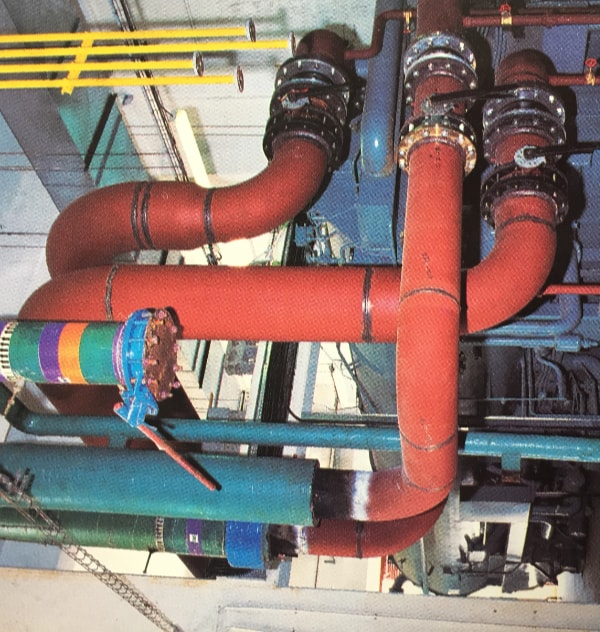 It was no small feat when in 1997 NGC attained its 100th customer (17 major and 83 small). In the latter category, NGC had a major breakthrough in the use of natural gas in ‘cooling applications’ by the Maritime Centre, which signified the first time gas-fired, air-conditioning had been used commercially in the country. This paved the way for other cooling systems to be commissioned in the country and for the distribution network to be expanded to the northwestern peninsula at Cocorite.
It was no small feat when in 1997 NGC attained its 100th customer (17 major and 83 small). In the latter category, NGC had a major breakthrough in the use of natural gas in ‘cooling applications’ by the Maritime Centre, which signified the first time gas-fired, air-conditioning had been used commercially in the country. This paved the way for other cooling systems to be commissioned in the country and for the distribution network to be expanded to the northwestern peninsula at Cocorite.
From the administrative and financial level, NGC made significant strides in becoming a global company through its negotiation with multinationals, international financial houses and agencies.
It successfully finalised the Principles of Agreement with Amoco to renegotiate the terms of the gas supply agreement and construction of offshore and onshore pipelines.
It finalised a TT$544.3 million Standby Letter of Credit with a syndicate of international banks which was established as security for long-term loans.
Finalisation of a TT$158 million Fixed Rate Bond with Citibank Trinidad and Tobago for the financing of its 10% equity share in Atlantic LNG through NGC’s new subsidiary NGC Trinidad and Tobago LNG Limited.
NGC also negotiated amendments to the Natural Gas Processing Agreement with PPGPL in 1997 whereby PPGPL would increase its gas processing capacity from 750 MMscf/d to 1,350 MMscf/d.
Through its strategic investments and with a focus on its mandate, NGC continued to expand its asset base and profitability. NGC recorded a profit of TT$353 million, a 5% increase over the previous year and assets increased by 28% to more than TT$2 billion and which were attributed to developmental works on pipeline and port infrastructure. Gas purchases and sales averaged 717 MMscf/d, which represented an increase of 5% over the previous year.
In terms of human development and efficiency, NGC commenced an exercise to redesign the organisation and participated as a key stakeholder in the establishment of the National Energy Skills Center whose objective is to further human resource development within the country, in particular the energy sector.
NEC specialises
Another major move took place in January 1999 when NEC was reoperationalised as a separate subsidiary entity with responsibilities for providing and managing port and marine facilities at Port Point Lisas; the management of the La Brea Estate and adjoining port on behalf of LABIDCO, as well as the continued development of new industrial sites.
Although reoperationalised within the ambit of an emerging NGC Group of Companies, the move signaled the new focus towards improving the performance and efficiency of the NGC Group at specific activities.
Navigating turbulence
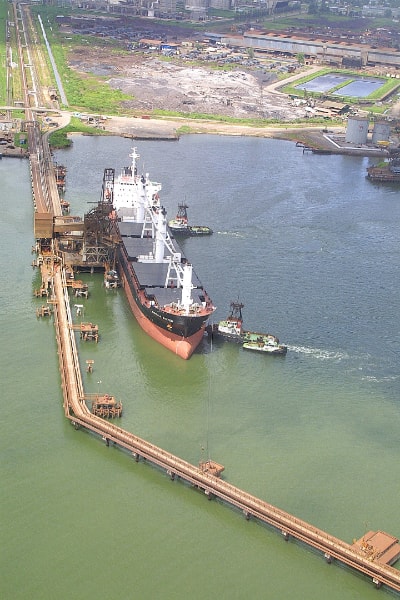 Depressed petrochemical and iron and steel market prices in 1998 and 1999 saw NGC’s profit returns take a sharp decline. Profit margins fell precipitously from TT$353 million in 1997 to TT$19 million in 1998, and while there was some recovery mainly arising from the robust performances of subsidiary companies, the NGC Group in 1999 recorded a net profit of TT$33.7 million.
Depressed petrochemical and iron and steel market prices in 1998 and 1999 saw NGC’s profit returns take a sharp decline. Profit margins fell precipitously from TT$353 million in 1997 to TT$19 million in 1998, and while there was some recovery mainly arising from the robust performances of subsidiary companies, the NGC Group in 1999 recorded a net profit of TT$33.7 million.
Despite the constraints imposed by the depressed market conditions, natural gas remained the fastest-growing energy source in the world and was evidenced by the fact that the country remained a prime investment location for gas-based operations while the Point Lisas Estate was now home to 22 large industrial plants.
Natural gas, compared to the other available fossil fuels, remained the cheapest fuel enabling NGC to market natural gas to the growing light industrial/commercial sector, which comprised 95 small consumers on the distribution network.
In addition, new petrochemical plants were on the drawing board, requiring the construction of a new marine and port facility at Port Point Lisas, the state-of-the-art, Savonetta Pier No. IV. This multiuser pier was viewed as being key to the overall strategy of meeting the import and export needs of new customers locating their businesses at Point Lisas. By the end of 1999, the outlook for the industry, the economy and NGC was, at least in the medium term, favourable, having passed the worst.
Attracting investment
The successful commissioning of LNG Train 1 in the last quarter of 1999 was heralded as the first Greenfield LNG project to be developed within a short gestation period in the Western Hemisphere in 25 years in a small country such as Trinidad.
NGC’s prominent role in the creation of LNG Train 1 and the country’s bold and ambitious utilisation of natural gas attracted the attention of international investors interested in establishing methanol and ammonia plants as well as value added processes like aluminium and ethylene.
NGC had surpassed its different mandates and expectations by successfully constructing a flourishing new energy landscape that enhanced shareholder value and brought numerous benefits to the country. A new role was now thrust upon NGC, elevating from it ‘prime mover’ to ‘keeper of the flame’ which impacted NGC’s activities, both at home and abroad.
At the end of the 1990s, NGC emerged as a successful group of companies with interests spanning the entire spectrum of the gas business. NGC with NEC and Labidco also provided an integrated ‘one-stop-shop’ service to new investors seeking to locate natural gas-based industries in Trinidad and Tobago.